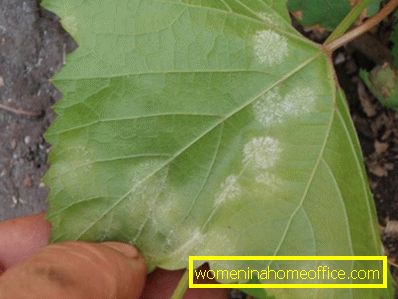Why the leaves turn yellow grapes
Grapes are cultivated since ancient times. The mention of this berry can be found even in biblical tales. Currently, lush vines adorn many summer cottages. But grapes are quite capricious and often sick. The most common symptom is yellowing of the leaves of the plant.
Grapes: yellow leaves
The problem of yellowing leaves worries many experienced gardeners and amateur gardeners. The leaves of the plant can curl for several reasons:

- Lack of nitrogen in the soil. At first the leaves are lightened evenly, gradually turning yellow. To eliminate the yellowness in this case, it is enough to feed the grapes with fertilizers containing nitrogen. Suitable cow dung or chicken droppings, as well as special tools from stores.
- The next reason for the yellowing of leaves lies in the disease chlorosis. This is the most dangerous disease affecting the plant. Chlorosis is most common in Russia due to the high content of carbonate compounds in soils. The disease manifests itself as yellowing between the veins and the soft part of the leaves. If chlorosis is manifested sharply, the leaves turn sharply yellow. New leaves, growing at the place of the dead, dried, small and thin. Also, due to chlorosis, bunches of grapes may be affected, and, consequently, berries. Clusters become small, as a result, yield is reduced. The general condition of the plant is deteriorating.
- Usually, the leaves of the grapes begin to turn yellow due to chlorosis in the spring or in the 2nd half of summer. To avoid disease, improve air and moisture permeability of the soil. To do this, you need to periodically loosen and mulch the soil.
Spots on grape leaves: causes
Spots on the leaves appear due to diseases that are most susceptible to grapes. Mildew (downy mildew) is a common disease during which pale green or yellow spots appear on the leaves. Gradually, they begin to blush. A white fluff appears on the bottom of the leaves. The diameter of the spots can reach 3 cm.
Adult leaves have angular spots reaching 6 mm. Because of the spots, the foliage gradually begins to dry out and fall off. The berries affected by mildew become chocolate in color, and a blue stripe forms around the stem.

You can fight the disease as follows: when planting grapes, create the necessary conditions for it. The plant should be placed in a well-ventilated area. Rows of grapes are located along the wind, avoiding lowlands and wetlands, thinning, etc. If, with the observance of all the rules of planting, the plant is still sick with mildew, you will have to carry out chemical treatment.
Oidium - affects all green grapes. The first disease affects the leaves of the plant. First, oidium appears on the surface of the leaves, then infects the lower side, then spreads to shoots and cuttings. Some time after the appearance of a raid, brown spots appear on the leaflets. The affected leaves become brittle, dry and fall off.
Anthracnose appears on the leaves of grapes in the form of spots. First, yellowish spots appear, then they turn brown, and a dark rim appears around. Gradually, foliage develops in the foliage. White patches may appear on top of the stains. They fight anthracnose by cutting and destroying the affected parts of the plant. Be sure to spray the grapes with solution of iron sulphate. When buds bloom, it is recommended to spray 1 percent Bordeaux liquid.
Rubella is a disease that affects the leaves of grapes. Red spots with bright green rims appear in the corners between the large veins. Gradually the spots become red-brown. The optimal temperature for pathogens of the disease - 18 - 20 degrees. To combat the disease used 1% Bordeaux liquid.
Grapes - a perennial plant grown in the southern regions and central Russia. Wine, juice, jellies and compotes are made from it. In the berry many vitamins and minerals that are beneficial to humans. To avoid diseases of the vine, it is necessary to follow the rules for the care of the crop, to deal with pests in a timely manner.